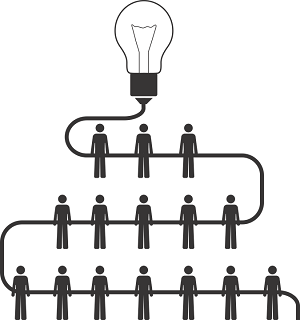e-Learning Ecologies MOOC’s Updates
An Overview of Collaborative Intelligence: from examples to animals-based behaviors
The concept of collaborative intelligence (CI) performs a crucial role especially in a society where teamwork is endorsed, and smart solutions are based upon multiple collaborations. It (the CI) consists of a form of intelligence that emerged from the mutual engagement where better results can be extracted, especially on decision-making contexts (Bonabeau, 2009). Besides, by taking the 21st-century corporative scenario, where artificial intelligence and machine learning brought the automation of so many tasks, the collaboration between humans and machines is also an urgent discussion. As explained by Cope and Kalantzis (2017), in a world-connected atmosphere, "there is no fact that cannot be looked up, no calculation that cannot be made using computational and data access tools in the myriad of apps." One can find a deeper discussion about the reasons the future of work lies in collaborative intelligence on this link: https://medium.com/@NextPlane/why-the-future-of-work-lies-in-collaborative-intelligence-cfcdb8086bea
However, to establish the importance of collaborative intelligence, taking the educational field by means to construct rich social learning, must be seen as a premise. Kids learning about the importance of collaborative work, giving and taking feedback, facilitate the need to put personal differences apart to build a promising and creative environment. It is also worth mentioning that the approach still adopted by formal schools and conservative attitudes of some teachers might contribute to keeping students more motivated in terms of grades and individual performance, than having intrinsic and collective points of interest. Those common standards can inclusively diminish collective intelligence (Morreau and Lyon, 2016). Such scholar and teaching-based resistance is a result of the fact neither schools being equipped with technical skills nor the teacher having the appropriate additional training. (Ilon et al, 2012).
In a world-connected such as the one we live, there's no way to think about collaborative intelligence without considering the effectiveness Information and Communication Technology (ICT) has proven to deliver, mainly in terms of innovation (Meza et al., 2017). Tools like Google (Docs, Sheets), Trello, Wikipedia, for instance, and even social media spaces like Facebook and Twitter corroborate this idea. Innovation and CI used to be thought only in terms of technology, but it has been changed, and mutual intelligence fosters innovation in all kinds of social phenomena. For example, a collective action started in the Boston area, became, in 2009, the Boston Public Schools Arts Education Expansion Initiative (BPS-AE). The public-private partnership invested in fostering equitable access to quality arts learning experiences covering the city's 56,000 public school students. Similar initiatives were then developed, ending up to a national coalition (Gibson, 2017).
Another interesting point to be observed is the origin of some of the insights into the study of collective intelligence in human teams. O'Bryan et al (2020) noticed areas where studies of swarm intelligence in animals can promote those insights. Honey bees colony and fish school behaviors have been analyzed as inputs to improve the study of CI in human teams. Those analyses are aimed not only to provide new ideas to human-to-human interaction, but also to be replicated to create intelligent algorithms.
The outcomes delivered by CI are, with no doubt, outstanding regardless of the sources used to foster it. Affirmative reciprocity, lifelong knowledge, and also the sense of community might be even higher when the entire process is instigated as soon as possible.
References:
Bonabeau, E. (2009). Decisions 2.0: The Power of Collective Intelligence. MIT Sloan Manag. Rev. 2009, 50, 45–52.
Cope, B., and Kalantzis, M. (2017). Conceptualizing e-learning. In B. Cope and M. Kalantzis (Eds), e-Learning Ecologies. New York: Routledge.
Morreau, M. and Lyon, A., 2016. How common standards can diminish collective intelligence: a computational study. Journal of Evaluation in Clinical Practice, 22(4), pp.483-489.
Ilon, L., Altmann, J., Bauml, U., Krmer, b. J. (2012). "How collective intelligence redefines education" in Advances in Intelligent and Soft Computing, Berlin, Heidelberg:Springer Berlin Heidelberg, vol. 113, [online] Available: http://doi.org/10.1007/978-3-642-25321-8.
Meza, J., Ortiz, O., Roman, S., M. Monguet, J. and Tomala, M., (2017). The ICT enhancing the creativity through collective intelligence. EAI Endorsed Transactions on e-Learning, 4(14), p.152903.
Gibson, C. (2017). Dancing to the top: How collective action revitalized arts education in Boston. Arts Education Policy Review. 119. 1-14. 10.1080/10632913.2017.1321075.
O'Bryan, Lisa & Beier, Margaret & Salas, Eduardo. (2020). How Approaches to Animal Swarm Intelligence Can Improve the Study of Collective Intelligence in Human Teams. Journal of Intelligence. 8. 9. 10.3390/jintelligence8010009.
What is Swarm Intelligence?:https://www.youtube.com/watch?v=jfoAYg-gk98
Link of an overview of some algorithms for swarm intelligence: https://link.springer.com/chapter/10.1007/978-3-642-23935-9_3



Very interesting. Thank you!